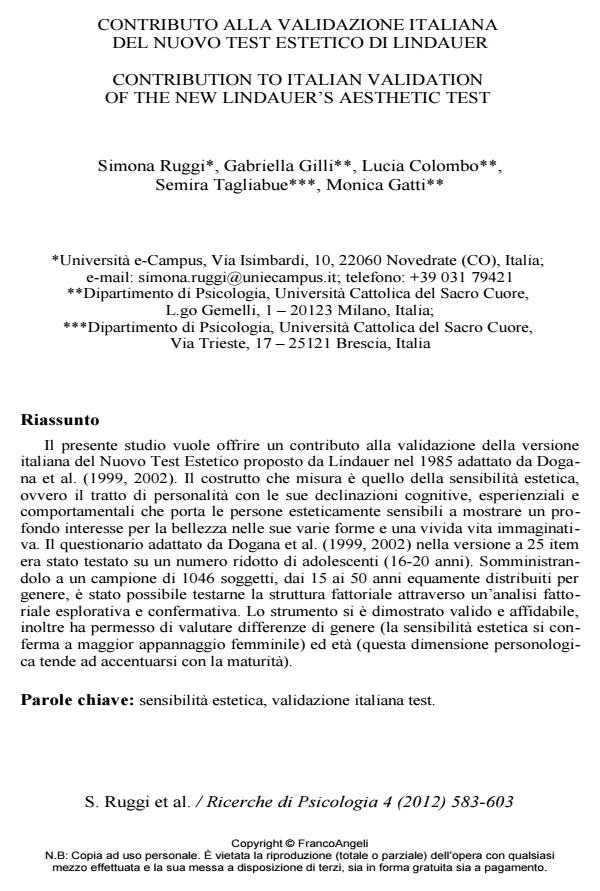Contributo alla validazione italiana del nuovo test estetico di lindauer
Titolo Rivista RICERCHE DI PSICOLOGIA
Autori/Curatori Simona Ruggi, Gabriella Gilli, Lucia Colombo, Semira Tagliabue, Monica Gatti
Anno di pubblicazione 2013 Fascicolo 2012/4
Lingua Italiano Numero pagine 21 P. 583-603 Dimensione file 244 KB
DOI 10.3280/RIP2012-004001
Il DOI è il codice a barre della proprietà intellettuale: per saperne di più
clicca qui
Qui sotto puoi vedere in anteprima la prima pagina di questo articolo.
Se questo articolo ti interessa, lo puoi acquistare (e scaricare in formato pdf) seguendo le facili indicazioni per acquistare il download credit. Acquista Download Credits per scaricare questo Articolo in formato PDF

FrancoAngeli è membro della Publishers International Linking Association, Inc (PILA)associazione indipendente e non profit per facilitare (attraverso i servizi tecnologici implementati da CrossRef.org) l’accesso degli studiosi ai contenuti digitali nelle pubblicazioni professionali e scientifiche
Il presente studio vuole offrire un contributo alla validazione della versione italiana del Nuovo Test Estetico proposto da Lindauer nel 1985 adattato da Dogana et al. (1999, 2002). Il costrutto che misura e quello della sensibilita estetica, ovvero il tratto di personalita con le sue declinazioni cognitive, esperienziali e comportamentali che porta le persone esteticamente sensibili a mostrare un profondo interesse per la bellezza nelle sue varie forme e una vivida vita immaginativa. Il questionario adattato da Dogana et al. (1999, 2002) nella versione a 25 item era stato testato su un numero ridotto di adolescenti (16-20 anni). Somministrandolo a un campione di 1046 soggetti, dai 15 ai 50 anni equamente distribuiti per genere, e stato possibile testarne la struttura fattoriale attraverso un’analisi fattoriale esplorativa e confermativa. Lo strumento si e dimostrato valido e affidabile, inoltre ha permesso di valutare differenze di genere (la sensibilita estetica si conferma a maggior appannaggio femminile) ed eta (questa dimensione personologica tende ad accentuarsi con la maturita).
Parole chiave:Sensibilita estetica, validazione italiana test
- Riflessivita, attivita grafico-pittoriche e arte: un circolo virtuoso Gabriella Gilli, in RICERCHE DI PSICOLOGIA 3/2016 pp.423
DOI: 10.3280/RIP2016-003011
Simona Ruggi, Gabriella Gilli, Lucia Colombo, Semira Tagliabue, Monica Gatti, Contributo alla validazione italiana del nuovo test estetico di lindauer in "RICERCHE DI PSICOLOGIA " 4/2012, pp 583-603, DOI: 10.3280/RIP2012-004001